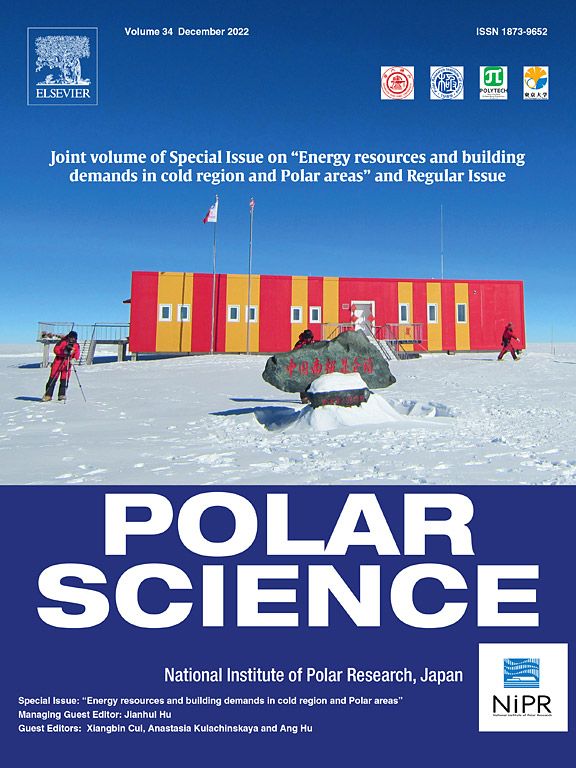National Institute of Polar Research
The academic journal “Polar Science” features Energy and Buildings in cold & Polar regions
December 28, 2022
The National Institute of Polar Research (NIPR) publishes Polar Science, a peer-reviewed quarterly journal dealing with polar science, in collaboration with Elsevier B. V. The special issue titled "Energy resources and building demands in cold region and Polar areas" was published as part of the latest issue (Vol. 34, posted on 1 December 2022). This issue focused on the research between buildings and energy, aiming to overview the recent scientific research, new technology, and future perspectives. This special issue consists of seven high-quality papers, which are state-of-the-art multi-disciplinary work performed by international researchers. The full text of issue 34 will be freely accessible worldwide until 31 May 2023.

It is gradually becoming clear that recent global climate changes are more pronounced in parts of the Polar areas. In turn, it has also become clear that the environmental changes in Polar regions significantly affect low-latitude ecosystems and human activities. In addition, global warming has opened up the ocean areas previously closed by large-scale thick ice, raising some expectations for the economical use of these areas for sea routes and oil/natural gas field development.
These factors have made research and development more critical in cold and polar regions. Despite the progress of global warming, these areas are still the coldest and driest environments on Earth. Thus, special provisions are required for buildings used for living (Cold regions and Arctic) and research (Antarctic). Building performance in such areas depends on local materials, particular structural types, energy resources, and possible supply ways. However, the basic relationship between energy use and building thermal performance in such areas has yet to be revealed due to limited research.
“In this special issue, the results of a broad field are collected to understand the relationship between buildings and energy," said Dr. Jianhui Hu, a tenure-track Associate Professor at Shanghai Jiao Tong University and the Managing Guest Editor of this issue. " The traditional methods can generate or obtain a large amount of valuable data while the cutting-edge technology has the advantage of opening up new research areas. Therefore, the results and conclusions combined with traditional methods and new techniques are essential to understanding the basic relationship between buildings and energy in these fields.”
Data from decades of traditional methods are now available as big data and can be analyzed on a regional basis. By applying artificial intelligence to such big data, it should be possible to identify, among many factors, the critical factors for clarifying the relationship between buildings and energy resources. Based on these new techniques, the issue reported the efficient submarine pipeline design results using artificial intelligence and a study of safe and fuel-efficient navigation routes based on the associated real-time satellite data.
“I hope this special issue can draw more attention from the academic and engineering community to enhance or start research on buildings and energy in such areas. With new ideas, novel techniques, and newly-built projects, in the near future, I believe that we will understand how the buildings and energy resources interact with each other, which will open the way to the use of limited energy to maintain the required building performance. There is also great potential for new engineering fields in polar and extraterrestrial areas, such as the moon and Mars,” said Dr. Jianhui Hu.
About Special Issue of Polar Science Volume 34
Title : Energy resources and building demands in cold region and Polar areas
Managing Guest Editor : Jianhui Hu
Guest Editors: Xiangbin Cui, Anastasia Kulachinskaya, Ang Hu
URL: https://www.sciencedirect.com/journal/polar-science/vol/34/
About Polar Science
Polar Science is a peer-reviewed comprehensive academic journal relating to the polar regions of the Earth and other planets, which the NIPR began to publish in collaboration with Elsevier B.V. in 2007. The primary purpose of this journal is to inform people about polar science. Currently, more than 100 articles are submitted per year. As a result, this journal is recognized globally as one of the few comprehensive academic journals in the field of polar science. In addition to normal issues, Polar Science publishes a special issue annually on a given topic from various fields.
The main characteristics of Polar Science are summarized as follows.
- Polar Science is an international academic journal with an impact factor of 2.355 as of 2021
lPolar Science covers 15 disciplines related to the Antarctic and the Arctic, such as:
- Space and upper atmosphere physics
- Atmospheric science/Climatology
- Glaciology
- Oceanography/Sea ice studies
- Geology/Petrology
- Solid earth geophysics/Seismology
- Marine earth science
- Geomorphology/Cenozoic-Quaternary geology
- Meteoritics
- Terrestrial biology
- Marine biology
- Animal ecology
- Environment
- Polar engineering
- Humanities and social sciences - Polar Science has an Open Archive whereby published articles are made freely available from ScienceDirect after an embargo period of 24 months from the date of publication.
- Printed products are also published.
- After Polar Science became an open archive in 2016, article downloads have increased rapidly since then. Currently, more than 180,000 papers are used (PDF download and HTML Views) annually.








